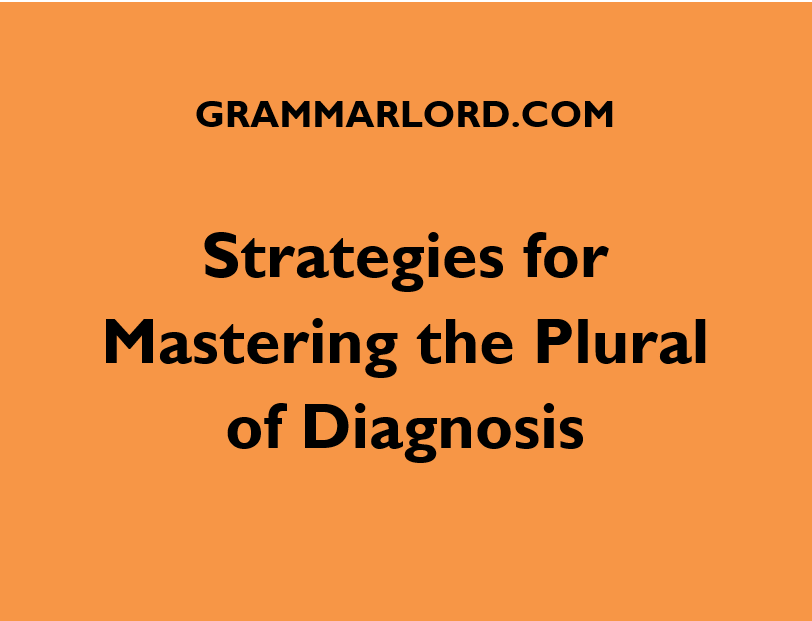Whether it’s “diagnosis or diagnoses”, the doctor will definitely do his job. But one is singular and the other is plural, plus it’s not quite as straightforward as adding an “s” and calling it a day.
Happily, this article is here to help you. You see, “diagnosis” has a bit of a fancy background, originating from the land of ancient Greek. And in Greek, things get a bit interesting when it comes to plurals.
Unlike in English words which follow a pretty predictable pattern. You simply add an “s” for most words, like “books,” “cats,” or even “buses” (though some like “bus” prefer an “es”). But “diagnosis” isn’t content with playing by the rules. It remembers its Greek roots and throws a little curveball our way.
READ ALSO: What is The Past Tense Of Swing; A Useful Guide
Contents
Now the plural form of diagnosis
The proper plural of “diagnosis” is “diagnoses.” Yes, that’s right, it replaces the ending “is” with an “es”. It’s like a chameleon, blending in with the regular “es” crowd but secretly holding onto its Greek heritage.
But why should you use “diagnoses”?
Well, some folks might argue that “diagnosis” would be more logical, following the pattern of words like “oasis” or “crisis.” But in the grand game of language, usage often moves ahead of logic.
And over time, “diagnoses” has become the universally accepted plural form. It’s the one you’ll find in dictionaries, medical charts, and even on that fortune cookie you got last week.
It’s possible you want to ask: Isn’t ‘diagnosis’ already sounding plural? And you’re not wrong.
The “sis” ending gives it a bit of a plural vibe, which might be why some folks get confused. But remember, it’s all about consistency and playing by the rules (even if those rules come from ancient Greece).
READ ALSO: Secrets to Unlocking the Past Tense of Rise
Let’s interlocking all the pieces.
But here’s the thing, if you’re writing something formal, like a medical report or a research paper, sticking to “diagnoses” is your safest bet. It’s the grammatically correct and universally understood way to refer to multiple diagnoses.
Using “diagnosis” in this context could create confusion, like a detective giving you just one clue and expecting you to solve the whole case.
Now, let’s crack our brain a little; Why is “diagnoses” the go-to plural instead of, say, “diagnosi”? We can blame it on the ancient Greeks my friend.
Like I mentioned in the beginning, “diagnosis” has Greek roots, and in that language, nouns ending in “-sis” often take “-ses” as the plural. English borrowed this rule (along with many other words, let’s be honest), and that’s how “diagnoses” was born.
Examples of how to use the words “diagnosis” and “diagnoses”
Singular “diagnosis”:
The doctor gave her a diagnosis of pneumonia. (This refers to the specific identification of the illness after examining the patient.)
His early diagnosis of cancer saved his life. (This emphasizes the importance of identifying the condition early.)
The differential diagnosis included several possibilities, so further tests were needed. (This refers to the initial list of potential conditions considered before reaching a conclusive diagnosis.
She struggled to cope with the emotional impact of her diagnosis. (This focuses on the psychological and social aspects of living with a particular condition.)
READ ALSO: Steps to Make Sense of the Past Tense of Smell
Plural “diagnoses”:
He has received multiple diagnoses throughout his life. (This refers to the accumulation of several medical conditions over time.)
The hospital recorded hundreds of diagnoses in the emergency room that day. (This implies a large number of patients seeking medical attention for various illnesses.)
My grandma passed away after a long battle with various diagnoses. (This acknowledges the complexity of her medical history with multiple conditions.)
The study compared the effectiveness of different treatments for various diagnoses. (This focuses on research related to diverse medical conditions.)
Note: Use “diagnosis” when referring to a singular instance of identification of a condition and “diagnoses” when referring to multiple conditions, a general concept, or statistical data.
READ ALSO: What You Need to know about the Plural of Appendix
Final Thoughts
I do hope your confusion about which is the plural between “diagnosis” or “diagnoses have been settled. And for the sake of emphasis, “diagnoses” is the plural of “diagnosis”.
The added examples were meant to print a clearer picture in your mind, while you master which one to use. At last, you can now avoid those awkward grammar rifts, plus communicate without fear of mistakes.

